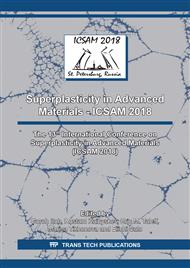[1]
S. Semiatin and T. Bieler, The effect of alpha platelet thickness on plastic flow during hot working of TI–6Al–4V with a transformed microstructure, Acta Mater. Vo.49 (2001) 3565-3573.
DOI: 10.1016/s1359-6454(01)00236-1
Google Scholar
[2]
S. V. Zherebtsov, E. A. Kudryavtsev, G. A. Salishchev, B. B. Straumal, and S. L. Semiatin, Microstructure evolution and mechanical behavior of ultrafine Ti6Al4V during low-temperature superplastic deformation, Acta Mater. Vol.121 (2016) 152-163.
DOI: 10.1016/j.actamat.2016.09.003
Google Scholar
[3]
H. Matsumoto, V. Velay and A. Chiba, Superplasticity of the Ultrafine-Grained Ti-6Al-4V Alloy with a Metastable α-Single Phase Microstructure, in Proceedings of the 13th World Conference on Titanium (eds V. Venkatesh, A. L. Pilchak, J. E. Allison, S. Ankem, R. Boyer, J. Christodoulou, H. L. Fraser, M. A. Imam, Y. Kosaka, H. J. Rack, A. Chatterjee and A. Woodfield), John Wiley & Sons, Inc., Hoboken, NJ, USA (2016).
DOI: 10.1002/9781119296126.ch133
Google Scholar
[4]
M. Ashby, R.Verrall, Diffusion-accomodated flow and superplasticity, Acta Metall. 21 (1973) 149-163.
DOI: 10.1016/0001-6160(73)90057-6
Google Scholar
[5]
E. Alabort, P. Kontis, D. Barba, K. Dragnevski, and R. C. Reed, On the mechanisms of superplasticity in Ti–6Al–4V, Acta Mater. Vol.105 (2016) 449–463.
DOI: 10.1016/j.actamat.2015.12.003
Google Scholar
[6]
Velay, V., Matsumoto, H. , Sasaki, L. and Vidal, V., Investigation of the mechanical behaviour of Ti‐6Al‐4V alloy under hot forming conditions, Mat.‐wiss. u. Werkstofftech, Vol.45 (2014) 847-853.
DOI: 10.1002/mawe.201400293
Google Scholar
[7]
V. Velay, H. Matsumoto, V. Vidal, and A. Chiba, Behavior modeling and microstructural evolutions of Ti–6Al–4V alloy under hot forming conditions, International Journal of Mechanical Sciences. Vol.108-109 (2016) 1-13.
DOI: 10.1016/j.ijmecsci.2016.01.024
Google Scholar
[8]
H. S. Yang, G Gurewitz and A. K. Mukherjee, Mechanical Behavior and Microstructural Evolution during Superplastic Deformation of Ti-6Al-4V, Materials Transactions, Vol.32 (1991) 465-472.
DOI: 10.2320/matertrans1989.32.465
Google Scholar
[9]
P. M. Souza, H. Beladi, R. Singh, B. Rolfe, and P. D. Hodgson, Constitutive analysis of hot deformation behavior of a Ti6Al4V alloy using physical based model, Materials Science and Engineering. Vol.648 (2015) 265–273.
DOI: 10.1016/j.msea.2015.09.055
Google Scholar
[10]
J. J. Jonas, C. Aranas, A. Fall, and M. Jahazi, Transformation softening in three titanium alloys, Materials & Design. Vol.113 (2017) 305–310.
DOI: 10.1016/j.matdes.2016.10.039
Google Scholar
[11]
J. W. Elmer, T. A. Palmer, S. S. Babu, and E. D. Specht, In situ observations of lattice expansion and transformation rates of α and β phases in Ti–6Al–4V, Materials Science and Engineering, Vol.391 (2005) 104–113.
DOI: 10.1016/j.msea.2004.08.084
Google Scholar
[12]
S. Malinov, P. Markovsky, W. Sha, and Z. Guo, Resistivity study and computer modelling of the isothermal transformation kinetics of Ti–6Al–4V and Ti–6Al–2Sn–4Zr–2Mo–0.08Si alloys, Journal of Alloys and Compounds. Vol.314 (2001) 181-192.
DOI: 10.1016/s0925-8388(00)01227-5
Google Scholar
[13]
F. A. Mohamed, Micrograin Superplasticity: Characteristics and Utilization, Materials, Vol.4 (2011).
Google Scholar
[14]
E. Alabort, D. Putman, and R. C. Reed, Superplasticity in Ti–6Al–4V: Characterisation, modelling and applications, Acta Mater. Vol.95 (2015) 428–442.
DOI: 10.1016/j.actamat.2015.04.056
Google Scholar
[15]
J. Koike et al., Stress-induced phase transformation during superplastic deformation in two-phase Ti–Al–Fe alloy, Acta Mater. Vol.48 (2000) 2059–(2069).
DOI: 10.1016/s1359-6454(00)00049-5
Google Scholar


